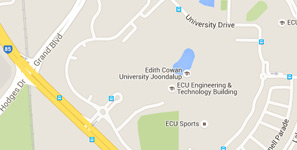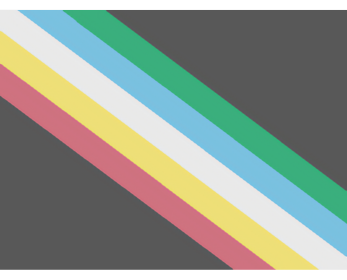ECU is celebrating Disability Pride Month this July.
Disability Pride Month is a celebration of disability identity, community, and advocacy. Historically, ableist ideas of disability have been socially constructed as the truth, where disability is seen as something shameful to be hidden from public space. Disability Pride is a response and counteraction against these ableist social stigmas, placing the autonomy of disabled identity into the hands of people with disability to define.
Jax Jacki Brown, a prominent Australian disability advocate writes; ‘The concept that a disabled person can feel proud of who they are and, indeed, can love their disability, runs counter to the common perception of disability as tragedy and the assumption that people with disabilities should seek to hide or feel ashamed of our difference. Disability Pride instead proclaims that disability is an aspect of culture and identity, and that many of the barriers disabled people face are due to an inaccessible society and not because our bodies or minds are different.’
History of Disability Pride Month
Like many times of significance including LGBTIQA+ Pride Month and Black History Month, the roots of Disability Pride month are in community advocacy.
On March 12, 1990, over a thousand people marched from the White House to the U.S Capitol to demand that the US congress pass the Americans with Disabilities Act. When activists arrived at the Capitol, sixty disabled activists demonstrated the inaccessibility of public spaces by getting out of the mobility aids and crawling up the Capitol steps in an act of civil disobedience later known as the Capitol Crawl. This monumental demonstration came after decades of activism by American disability activists and led to the signing of the Americans with Disabilities Act on July 26, 1990.
Disability Rights Movement in Australia
In an Australian context, the first known direct action by people with disability was at Weemala institution in the Sydney suburb of Ryde between 1971 and 1973. At Weemala, disabled activist John Roarty, organised inmates and formed a Resident’s Committee to campaign for choice and control over their lives. Direct action and activism by people with disability continued during the 1970s and included a protest led by activists Joan Hume and Genni Batterham who disrupted the opening of the inaccessible Eastern Suburbs Railway at Bondi Junction.
By the end of the 1970s, the Disability Action Forum was established by Victorian activists Geoff Bell, Rob McNamara and Frank Stevens. Lesley Hall writes, ‘[The Disability Action Forum] was the first major initiative that was developed around people with disabilities coming together themselves and organising… [it] was unique in the late ‘70s’.
1981 was a turning point in the history of the Australian and international disability rights movement. The United Nations declared 1981 the International Year of Disabled Persons, and called for a plan of action on the right of persons with disabilities to take part fully in the life and development of their societies, enjoy living conditions equal to those of other citizens, and have an equal share in improved conditions resulting from socio-economic development. A shift occurred in the disability rights movement with greater connections to advocacy occurring internationally, especially the budding disability civil rights movement in the United States.
Frank Hall-Bentick writes, ‘International Year of Disabled Persons was a catalyst for us to come together to be more organised about addressing the issues challenging the system’. The 1970s and 1980s laid the foundations and networks for key policy developments of the 1990s and early 2000s. The passage of the landmark Disability Discrimination Act (DDA) occurred in 1992 and created a legal avenue for people with disability experiencing discrimination.
Disability Pride Flag
The original disability pride flag, which featured brightly coloured zigzagging stripes over a black background, was created in 2019 by writer Ann Magill, who has a lived experience of disability. Magill said that the zig-zag shape of the original design “represents how disabled people have to manoeuvre around all the barriers we face. We have to go this way and then we have to go that way, and then we have to go this way and then we have to go that way. And that’s how we move through the world."
In 2021, the flag was redesigned following feedback from individuals with visually triggered disabilities. Magill reached out to the community to help with the redesign which features softer colours and straight stripes. The order of the stripes was also changed to accommodate people with red-green colour-blindness. "I think it’s even better this way because it truly represents the community because the community came together to solve a problem," Magill shared. The change to parallel stripes on the flag represents solidarity within the disability community and all its difference.
The colours of the flag are symbolic:
- Black: The faded background represents the anger and mourning over the eugenics and the neglect that disabled people have to fight against
- Red: represents physical disabilities.
- Gold: represents neurodivergence
- White: represents invisible disabilities and disabilities that have not yet been diagnosed
- Blue: represents emotional and psychiatric disabilities, including mental illness, anxiety, and depression
- Green: represents sensory disabilities, including Deafness, Blindness, lack of smell, lack of taste, audio processing disorder, and all other sensory disabilities
Celebrating Disability Pride Month
Everyone has a part to play in creating safe and inclusive environments for people with disability. Here are some ways that you can show allyship to the disability community this Disability Pride Month.
a) Do your own learning
Instead of relying of people with disability to educate you on disability inclusion, find opportunities to learn more about and connect with the disability community. This can include attending online webinars on disability inclusion, researching disability advocacy organisations in your area and following disabled advocates on social media.
b) Seek out the perspectives of people with disability
When learning more about disability, it is important that the voices of people with lived experience are centred. People with disability are the experts in what it is like to live with disability, and books, movies and videos written and/or featuring people with disability are an important part of sharing accurate information about disability.
c) Reflect on your language use
Inclusive language makes sure that we don’t leave people out of our conversations. It indicates to everyone from diverse backgrounds and communities that they are acknowledged and celebrated for their individuality, and for the contributions they make to wider society. ECU has an Inclusive Language Guide, a tool guide the ECU community to make sure that working and studying at ECU is an inclusive and positive experience for everyone.

